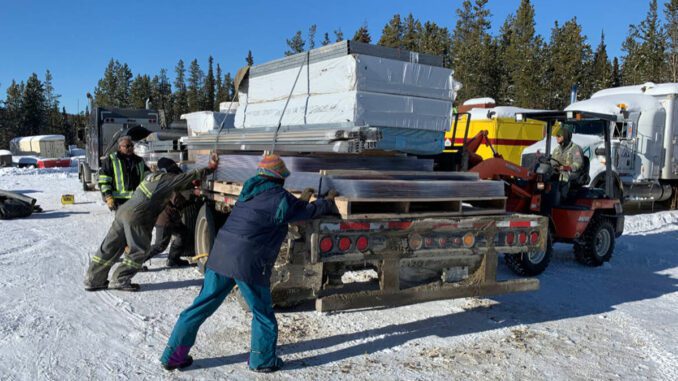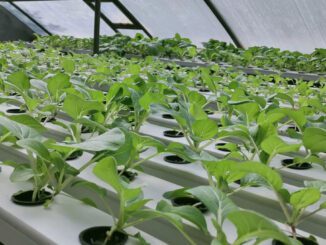
Sarah’s Harvest constructing passive solar greenhouse
Passive solar greenhouse construction | Gabrielle Plonka |
When life gives you sunshine, trap it in the soil and grow lemons with it — or maybe tomatoes, herbs and cucumbers.
That’s Sarah Ouellette’s plan, after she constructs the Yukon’s first commercially producing passive solar greenhouse.
Ouellette is the owner and operator of Sarah’s Harvest, an organic market garden located near Lake Laberge. Ouellette has been growing herbs and vegetables for a decade, selling produce at Whitehorse’s Fireweed Market and other retailers.
Last year, Sarah’s Harvest grew about 20,000 pounds of produce.
In addition to attention to living soil, Ouellette focuses on crops that thrive outside in northern conditions, like greens and root vegetables; her market table is stocked with electric-orange carrots, hearty bushels of kale and bright bouquets of herbs.
“Most of the field crops that we grow can tolerate at least a little bit of frost and grow quickly enough to mature during our season,” Ouellette said.
“Whereas, the greenhouse will allow me to grow crops that need more heat and protection … and we’re excited to grow a greater variety of food for the community.”
She already uses passive solar technology in a small-scale greenhouse. Insulated curtains are shuttered overnight and temperatures are monitored manually, with tanks of water acting as thermal mass to retain heat from the sun and barrel wood stove.
“In the spring, I can’t leave the farm,” Ouellette said. “I have to stay close, all the time, to manage the temperature in there.
“Things can spike up and down really suddenly, like if the clouds come out, or they go away, anytime the weather changes.”
The current greenhouse, which was built in 2005, is surrounded by growing trees casting counterproductive shade. It’s also a lot of work to maintain, Ouellette explained; it floods every spring and is too small for the garden’s growing needs.
After a “tremendous amount of research,” Ouellette opted to order a greenhouse kit from a company in Quebec. It just arrived on March 8.
This new greenhouse has timers and thermostats that will automatically kick in as they’re needed. A system of pipes will direct daytime heat into the ground and create a supplemental heat source overnight, helped by heat retention curtains and an insulated north wall.
Ouellette says the passive solar technique makes a “tremendous amount of sense” in the Yukon, especially in the spring.
“The nighttime temperatures can be so cold, and yet, the sun has a lot of energy and it’s free,” Ouellette said, explaining that frosty nights are the “hardest time” for crops.
The greenhouse will have a pellet stove and a wood stove, but the heat retention system will mitigate the need for both.
“Aside from labour, heating a greenhouse is usually the highest expense,” Ouellette said. “But with these pretty simple techniques, we can really minimize not only the financial expense but the environmental impact.”
The greenhouse, while cheaper in operating costs and in carbon footprint, will have hefty start-up costs. Ouellette said her best cost estimate is $230,000, a 15 per cent increase from last year; noting that inflation is constantly driving prices up.
The greenhouse project will be partially funded by the federal and territorial governments.
On Feb. 15, the Canadian Northern Economic Development Agency (CanNor) announced a pledge of $99,999 towards the project, with the Canadian Agriculture Partnership adding nearly $45,000.
The territorial department of Economic Development will also chip in about $30,000.
Ouellette also noted the help of several in-kind contributors, particularly noting Trent Jamieson and Niels Jacobsen.
“The volunteer support we’ve received is very humbling,” Ouellette said.
Minister Dan Vandal, who is responsible for CanNor, said the funding demonstrates the federal commitments to address food challenges north of 60.
“We are helping find local solutions to address food security issues across the North,” Vandal said.
Ouellette, who was named the Yukon’s Farmer of the Year in 2019, said that passive and organic strategies are key — from stewarding living soils to using a walk-in vegetable cooler chilled with 8,000 litres of ice frozen over the winter.
It’s all with the intention of advancing the Yukon’s food sovereignty.
“We’re in such a vulnerable position here, so much of our food comes from Outside,” Ouellette said.
“We’ve all seen the highways close and our grocery shelves empty. So, I really believe we need more local food.”
Original Article: https://www.yukon-news.com/local-news/sarahs-harvest-constructing-passive-solar-greenhouse/

